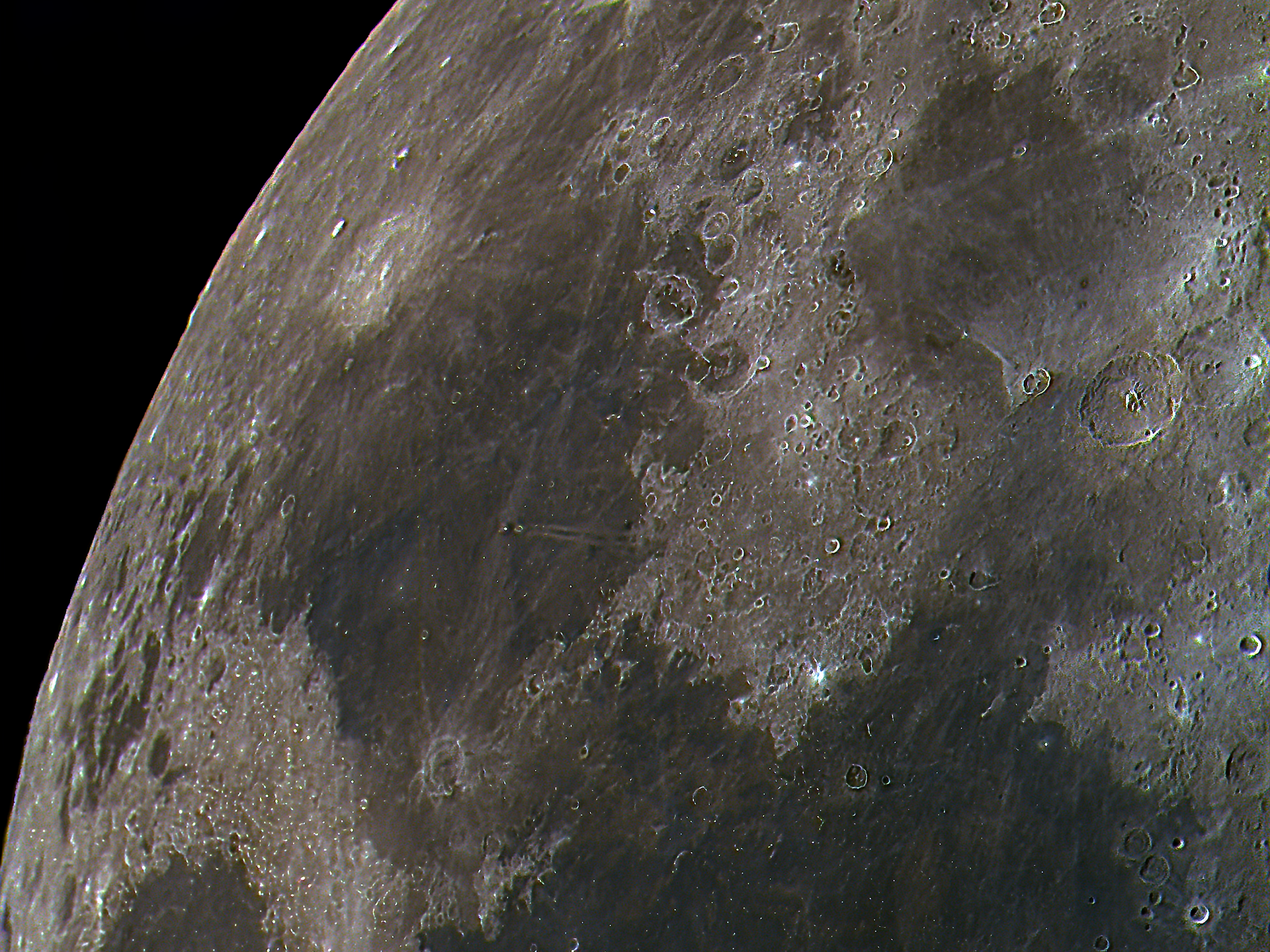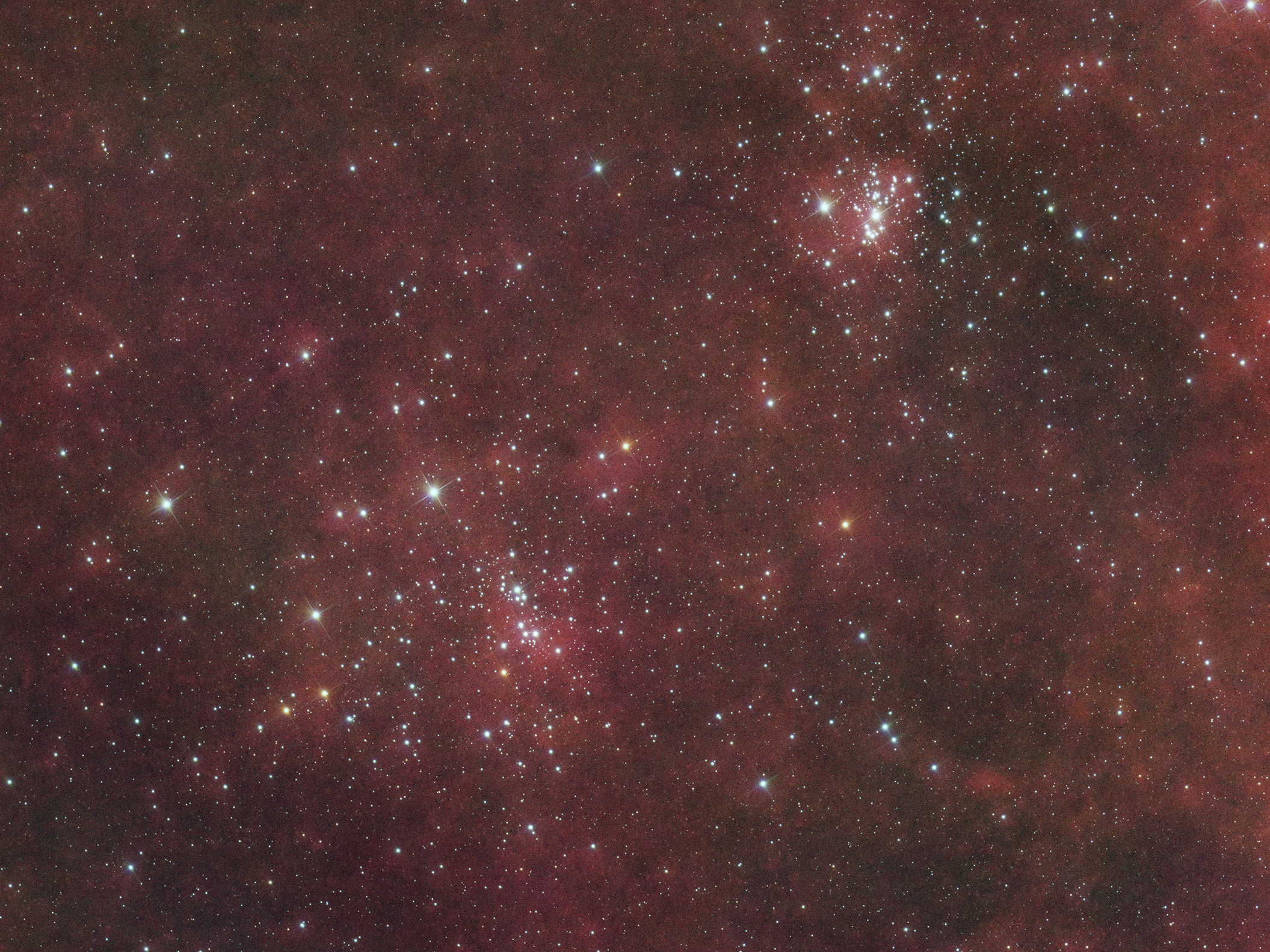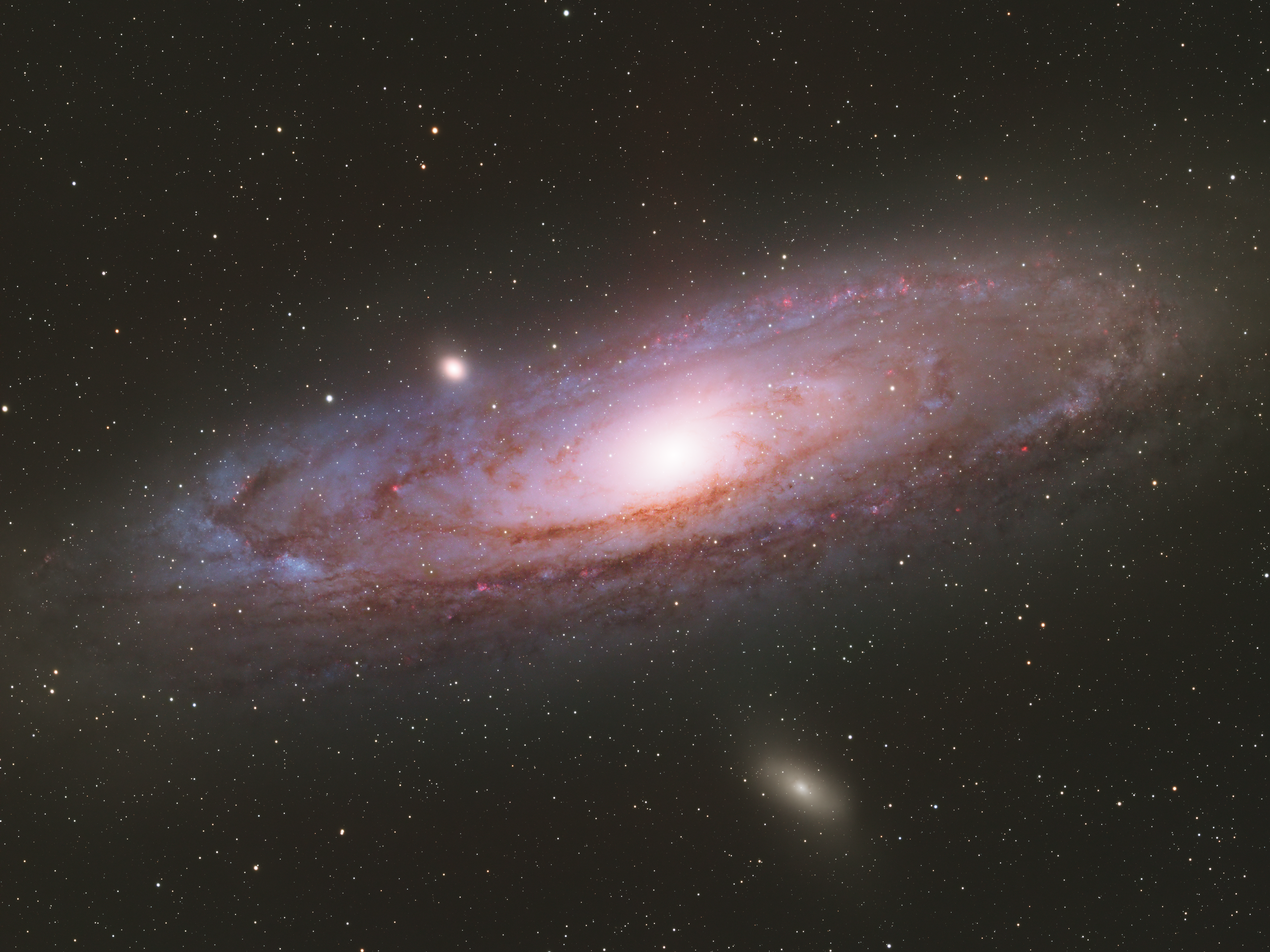
The Bubble Nebula, also known as NGC 7635, is a stunning emission nebula located about 7,100 light-years away in the constellation Cassiopeia. It owes its name to the nearly spherical, bubble-like structure created by the powerful stellar winds of a massive, hot O-type star (SAO 20575) at its center. The nebula is roughly 10 light-years in diameter, with its vibrant hues resulting from ionized gases, primarily hydrogen, glowing under the influence of intense ultraviolet radiation. The Bubble Nebula is a captivating example of the dynamic interactions between stars and their surrounding interstellar environments.

The Elephant’s Trunk Nebula, formally known as IC 1396A, is a striking concentration of interstellar gas and dust located within the IC 1396 emission nebula and star cluster in the constellation Cepheus, approximately 2,400 light-years from Earth. This dark, sinuous formation resembles an elephant’s trunk, giving the nebula its name. The structure is a stellar nursery, housing young, massive stars that carve out intricate shapes through powerful stellar winds and radiation. The Elephant’s Trunk Nebula is a fascinating region of ongoing star formation, where dense globules of gas collapse under gravity, potentially giving birth to new stars.

The Jellyfish Nebula, designated as IC 443, is a spectacular supernova remnant located approximately 5,000 light-years away in the constellation Gemini. It gets its name from its distinctive shape, which resembles a jellyfish with trailing tendrils of glowing gas. The nebula is the result of a massive star that exploded as a supernova between 3,000 and 30,000 years ago, leaving behind a complex web of filamentary structures. The shockwaves from the explosion interact with surrounding interstellar gas, creating vibrant emissions, particularly in hydrogen and sulfur wavelengths. The neutron star or pulsar left behind by the supernova lies near the nebula’s edge, adding to its astrophysical intrigue.

The Rosette Nebula, also known as NGC 2237, is a vast and beautiful emission nebula located about 5,000 light-years away in the constellation Monoceros (the Unicorn). Shaped like a blooming cosmic rose, this nebula spans roughly 130 light-years across and is part of a larger molecular cloud. At its heart lies the open star cluster NGC 2244, whose young, hot stars produce intense ultraviolet radiation that ionizes the surrounding hydrogen gas, causing it to glow with a vibrant red hue. The stellar winds from these stars also carve out the nebula’s central cavity, creating its distinct floral appearance. The Rosette Nebula is not only a visual wonder but also a region of active star formation, showcasing the life cycle of stars from birth to maturity.

The Veil Nebula, also known as NGC 6960 and sometimes referred to as the Cygnus Loop, is a breathtaking supernova remnant located approximately 2,400 light-years away in the constellation Cygnus (the Swan). It is the glowing remains of a massive star that exploded in a supernova event around 10,000 years ago. The nebula spans about 110 light-years and features delicate, wispy filaments of ionized gas, which give it the appearance of a translucent veil draped across the sky. The intricate structures and vivid colors result from shockwaves interacting with the interstellar medium, energizing elements such as hydrogen, oxygen, and sulfur. The Veil Nebula offers a unique glimpse into the life cycle of stars and the impact of supernovae on their surrounding environments.

The Christmas Tree Nebula, part of the larger NGC 2264 region, is a festive and enchanting star-forming region located about 2,600 light-years away in the constellation Monoceros (the Unicorn). The nebula gets its name from the triangular arrangement of stars resembling a Christmas tree, with the bright star S Monocerotis marking the tree’s trunk. The Cone Nebula, a dark, conical cloud of gas and dust, forms the tree’s tip. This region is a dynamic stellar nursery, with young, hot stars illuminating surrounding hydrogen gas, causing it to glow with a reddish hue. The interplay of dark dust lanes and glowing gas creates a visually captivating cosmic landscape, evoking the magic of the holiday season.

LDN 1272 is a dark nebula cataloged in Beverly T. Lynds’ Lynds’ Dark Nebulae Catalog. It is located in the constellation Cepheus, a region rich with interstellar dust and gas. Dark nebulae like LDN 1272 are dense clouds of gas and dust that block light from background stars and nebulae, appearing as dark, opaque patches against the luminous backdrop of the Milky Way. These nebulae often serve as stellar nurseries, where regions of higher density within the cloud can collapse under gravity to form new stars. LDN 1272, with its mysterious and obscured nature, offers a unique window into the early stages of star formation and the complex interactions within our galaxy’s interstellar medium.

The Heart Nebula, officially known as IC 1805, is a vast and vibrant emission nebula located about 7,500 light-years away in the constellation Cassiopeia. This nebula gets its name from its distinctive, heart-like shape, with glowing clouds of ionized hydrogen gas creating its bright, reddish appearance. At its core lies the Melotte 15 star cluster, a collection of young, massive stars whose intense radiation and stellar winds sculpt the surrounding gas and dust into intricate patterns. The Heart Nebula is part of a larger star-forming region in the Perseus Arm of the Milky Way and is often associated with its neighbor, the Soul Nebula (IC 1848), together forming the iconic “Heart and Soul” duo in the night sky.

The Horsehead Nebula, also known as Barnard 33, is one of the most iconic and recognizable dark nebulae in the night sky. It is located about 1,500 light-years away in the constellation Orion, within the vast Orion Molecular Cloud Complex. The nebula gets its name from its distinctive shape, which resembles the silhouette of a horse’s head set against the vibrant, red glow of the emission nebula IC 434 in the background. This red glow is produced by ionized hydrogen gas energized by the nearby bright star Sigma Orionis. The dark appearance of the Horsehead Nebula is due to thick clouds of cosmic dust and gas that block the light from behind. It is a region of active star formation, with dense pockets of gas serving as stellar nurseries where new stars are born.

The image captures the Flaming Star Nebula (IC 405) and the Tadpole Nebula (IC 410) glowing side by side in the Auriga constellation. The Flaming Star Nebula shines with fiery red and cool blue hues around the bright star AE Aurigae, while the Tadpole Nebula features soft, luminous gas with its signature “tadpole” structures silhouetted against the vibrant backdrop. The star-studded field adds depth and a sense of cosmic scale to this beautiful pairing of stellar nurseries.

The Ghost Nebula, also known as Sh2-136, is a reflection nebula located approximately 1,200 light-years away in the constellation Cepheus. This eerie nebula gets its name from its ghostly appearance, with wispy, translucent clouds of gas and dust resembling spectral figures floating against the dark backdrop of space. The nebula is illuminated by nearby stars, whose light reflects off the dust particles, giving the Ghost Nebula its soft, ethereal glow. It is part of a larger molecular cloud complex, a region of star formation where dense clumps of gas may eventually collapse under gravity to create new stars. The nebula’s haunting shapes and delicate structures make it a fascinating and visually captivating target for astronomers and astrophotographers alike.

Melotte 15 is a dazzling open star cluster situated at the heart of the Heart Nebula (IC 1805) in the constellation Cassiopeia, approximately 7,500 light-years from Earth. The cluster is home to a collection of young, massive stars, some of which are several times more massive than our Sun. These stars produce powerful stellar winds and intense ultraviolet radiation, which sculpt the surrounding gas and dust into striking formations, including pillars, ridges, and intricate shapes reminiscent of those in the Pillars of Creation within the Eagle Nebula. The dynamic interactions within Melotte 15 contribute to the ongoing process of star formation, making it a fascinating region for astronomers studying stellar evolution and the influence of massive stars on their interstellar environments.

M27, also known as the Dumbbell Nebula, is a bright and well-known planetary nebula located about 1,360 light-years away in the constellation Vulpecula. Discovered by Charles Messier in 1764, it was the first planetary nebula to be identified. The nebula’s name comes from its distinctive, dumbbell-like shape, created by the expanding shell of ionized gas ejected from a dying star. At the center lies a white dwarf, the remnant of the original star. The Dumbbell Nebula showcases vibrant colors, with reds and greens representing hydrogen and oxygen emissions, respectively. It provides a fascinating glimpse into the final stages of stellar evolution, demonstrating the fate that awaits stars like our Sun.

The Crescent Nebula, also known as NGC 6888, is a striking emission nebula located about 5,000 light-years away in the constellation Cygnus (the Swan). It was formed by the powerful stellar winds from the Wolf-Rayet star WR 136, a massive, hot star nearing the end of its life. These winds collide with material ejected during the star’s red giant phase, creating a shell of gas that glows as it is ionized by the intense ultraviolet radiation from the central star. The nebula’s delicate, arc-shaped structures and filaments of hydrogen and oxygen give it a crescent-like appearance, making it a fascinating object for studying the complex interactions of stellar winds and the lifecycle of massive stars.

The Iris Nebula, also known as NGC 7023, is a stunning reflection nebula located approximately 1,300 light-years away in the constellation Cepheus. Illuminated by the young, hot star SAO 19158, its soft, bluish glow arises as starlight reflects off surrounding dust clouds. The nebula’s intricate structures create a petal-like appearance, evoking the beauty of an iris flower, which inspired its name. The Iris Nebula not only captivates with its visual appeal but also serves as a fascinating stellar nursery, offering insights into the early stages of star formation and the interaction between light and interstellar dust.

















